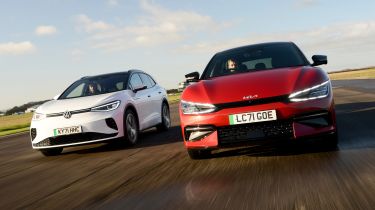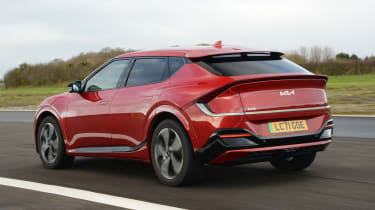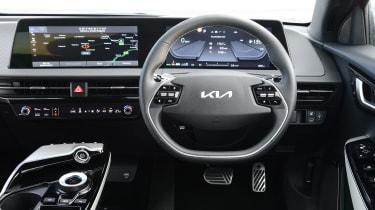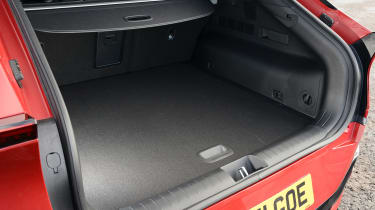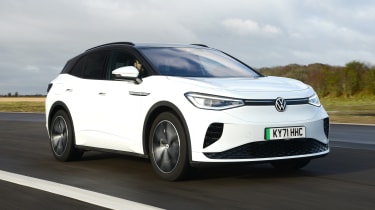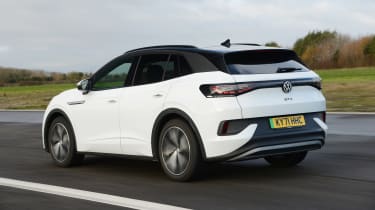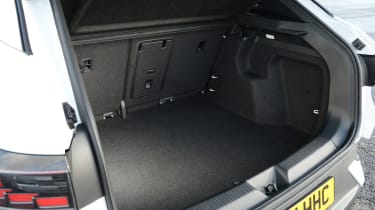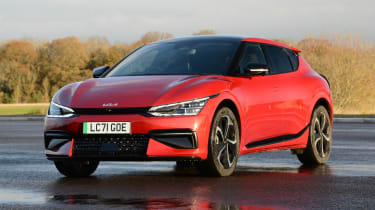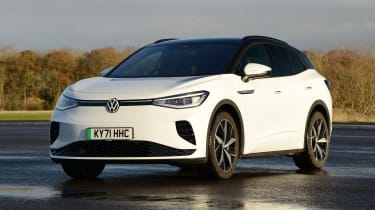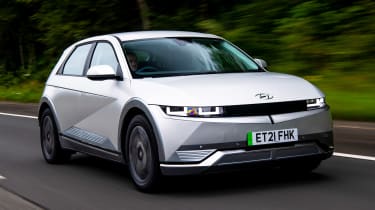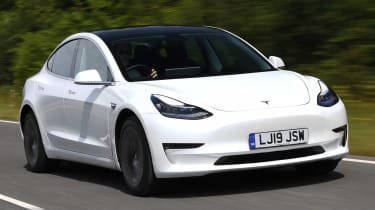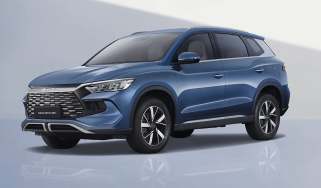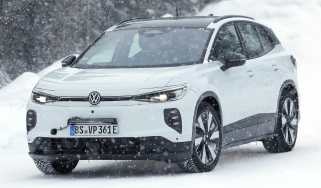Kia EV6 vs Volkswagen ID.4 GTX: 2022 group test review
The Kia EV6 and Volkswagen ID.4 GTX deliver sportiness to the electric SUV sector - but which does it best?
One of many emerging niches in recent years has been that of the fast SUV. These cars have settled into the hearts of buyers by offering the practicality and styling of a high-riding crossover, but with the performance of a hot hatch – and in some cases enough acceleration to worry genuine sports cars.
It was only a matter of time before all-electric options would join the party, and here are two of the latest of that breed: the Kia EV6 AWD and the Volkswagen ID.4 GTX. Both sit at the top of their respective ranges; above lesser variants that might be able to go further on a single charge. These models aren’t about ultimate efficiency, instead they deliver a healthy punch of performance, and are aimed squarely at those wanting to enjoy the electric driving experience a little more.
The EV6 is Kia’s latest electric car to arrive in the UK, and this is the first time we’ve pitched it against a rival in a twin test. We’ve already tried the regular ID.4, but this is our first time comparing the GTX with a rival, too.
While this EV6 won’t be the fastest version in the range – Kia has announced a GT variant that will be even more powerful – this AWD model is a similar price to the ID.4 GTX and both offer a range of 300 miles according to official figures. There are more similarities elsewhere: the batteries are of a similar size, performance should be fairly close and both are designed with extra driving enjoyment in mind.
Kia EV6
| Model: | Kia EV6 AWD GT-Line S |
| Price: | £51,945 |
| Powertrain: | 77.4kWh battery, twin e-motor, 321bhp |
| 0-62mph: | 5.2 seconds |
| Test economy: | 3.1mi/kWh |
| CO2: | 0g/km |
| Annual road tax: | £0 |
This is the top-spec version of the Kia EV6 AWD – a GT-Line S. This £51,945 model is the more expensive of the two cars here, but you could also opt for a lesser GT-Line car, which at £47,445 costs less than the ID.4 GTX.
Used - available now

2024 Fisker
Ocean
21,000 milesAutomaticElectric
Cash £17,490
2020 Skoda
Octavia Estate
50,857 milesAutomaticDiesel2.0L
Cash £13,590
2023 Volkswagen
Tiguan
38,722 milesAutomaticPetrol1.5L
Cash £24,250
2023 Hyundai
Kona
60,885 milesManualPetrol1.0L
Cash £12,499Design & engineering
The EV6 is the first model in Kia’s line-up to make use of the Hyundai Group’s E-GMP platform. It’s designed specifically for electric cars, with the batteries located under the floor. The platform allows for MacPherson struts at the front and multi-link rear suspension, so under the skin the EV6 crossover is pretty much identical to the Hyundai Ioniq 5.
Kia only offers the 77.4kWh model in the UK, and we’re testing it here in dual-motor AWD form. Each motor drives an axle independently for a total output of 321bhp and 605Nm of torque, which is very impressive. That’s about as much power as a typical hot hatch and more torque than is offered in a BMW M4. It’s quite a bit more than the ID.4 GTX, too, plus the Kia is slightly lighter as well, so its acceleration is very swift.
One of the more appealing parts of the Kia’s drivetrain is the 800-volt electrical set-up. It allows up to 350kW charging, so a 10-80 per cent charge can take as little as 17 minutes. Fast chargers capable of this aren’t very common in the UK right now, but it certainly helps to future-proof the EV6 as infrastructure gets better over the coming years. Even on a 50kW charger – a common type found at service stations – the Kia can charge
to the same capacity in just over an hour, which is a few minutes quicker than the VW.
GT-Line S trim is packed with all the equipment you need, including adaptive cruise control, a head-up display, keyless go, a powered tailgate, heated and cooled seats and an impressive twin-screen infotainment set-up with digital dials. The interior is a highlight overall – it feels spacious, while the materials and build quality feel a cut above the VW’s.
Driving
Thanks to those impressive power and torque figures, the EV6 delivers rapid acceleration. It will sprint from 0-62mph in 5.2 seconds – a full second faster than the ID.4. However, it feels a long way ahead of its rival in terms of both speed and driving enjoyment.
The Kia is a lot of fun on twisty roads because the motors are really responsive to your inputs – you can play with the throttle to adjust your line in corners in a natural way. This is in contrast to the VW, which has dull responses and a neutral attitude. The EV6 is one of the most enjoyable electric cars we’ve driven, in fact – it’s grippy and really fast, plus it’s well controlled in corners and there’s not much body roll.
There’s a bit of a trade-off, though because the Kia has a firm ride. It’s not unbearable, nor is it a problem on the motorway, but around town and on bumpy roads, the constant fidget makes it less comfortable than its rival. The Kia also suffers from numb steering, although the VW also has a similar issue.
Wind and road noise are fine, so the Kia is good for motorway trips, especially since the autonomous driving tech – essentially a fancy adaptive cruise control system – is easy to use and doesn’t brake harshly.
Practicality
With the battery located under the floor and within a huge wheelbase, the EV6’s cabin feels very spacious. This is most obvious in the back, where there’s lots of legroom. The driver’s seat is able to recline almost fully – ideal for relaxing during recharges – and there are plenty of useful cubbies, including a deep recess beneath the floating centre console.
The seats are comfortable, and on this top-spec model those in the front feature both heating and cooling functions. However, we found that it’s not ideal for taller drivers, because even with the driver’s seat in the lowest setting, we had little headroom in our normal driving position, nor could we see the entire digital dash panel.
The Kia is a bit less practical than its rival overall, because it has a 480-litre boot with the rear seats up, while the VW has a 543-litre boot. There’s a small storage area in the front boot for charging cables, but it’s not that useful for anything else.
Ownership
Safety is clearly a priority for the EV6, judging by its lengthy standard kit list; blind-spot warning, lane assist, autonomous cruise control, AEB and parking sensors with a camera are all included. While the Kia hasn’t been tested by Euro NCAP yet, the mechanically and structurally similar Hyundai Ioniq 5 earned a maximum five-star score.
Kia as a brand came in second place overall in the 2021 Driver Power customer satisfaction survey, which means the ownership experience should be excellent. Even the brand’s dealers scored well in the franchise survey. As with all Kias, the EV6 gets a seven-year/100,000-mile warranty.
Running costs
Both cars will be incredibly cheap to run. Company car buyers will pay around £200 to tax both models (as a higher-rate earner), while road tax is free for private buyers.
The Kia was more efficient than the VW on our test, returning 3.1 miles per kWh, compared with 2.7mi/kWh for the ID.4. It’s worth noting that we tested these cars in very cold conditions that will limit the range of both cars – in the summer we’d expect efficiency closer to each manufacturer’s claimed figures.
Testers’ notes
“The Kia’s two-spoke steering wheel looks quirky, but adds to a cabin that simply feels more futuristic than the VW’s interior.”
Volkswagen ID.4
| Model: | Volkswagen ID.4 All Wheel Drive GTX |
| Price: | £49,025 |
| Powertrain: | 77kWh battery, twin-e-motor, 295bhp |
| 0-62mph: | 6.2 seconds |
| Test economy: | 2.7mi/kWh |
| CO2: | 0g/km |
| Annual road tax: | £0 |
The Volkswagen ID.4 GTX’s name is designed to remind you of the brand’s famous GTI badge. There’s no petrol to inject here though, so that ‘I’ changes to an ‘X’ for this all-electric performance model at the top of the ID.4 range. It costs from £49,025, although with a heat pump (£1,020) and three-pin charging cable (£185) added, our car’s as-tested price was £50,895.
Design & engineering
As with the Kia, the ID.4 GTX uses a dedicated EV platform – in this case, the VW Group’s MEB architecture. Fundamentally, it’s quite a similar layout to the EV6’s, with the GTX’s 77kWh battery sitting under the floor, and an electric motor mounted on each axle.
As the performance-focused model of the range, the GTX benefits from some tweaks. It rides 15mm lower, and an electronic differential lock helps the ID.4 to deploy the 295bhp and 460Nm at its disposal.
Above our GTX model sits the GTX Max trim. The most notable extra that this has is the inclusion of DCC adaptive chassis control, which allows the driver to adjust the rate of response from the dampers and, VW says, lends the GTX an even broader spread between comfort and sharpness. Elsewhere, the ID.4 gets a beefy set of disc brakes up front, but in a rarity among modern performance cars, there are drum brakes at the rear. EVs make use of regenerative braking from the motors, so the demands on the physical brakes are lower; indeed it’s claimed that the drums will last the lifetime of the car.
Charging the VW takes longer than the Kia. Although you can make use of a 350kW charger in the EV6, the ID.4 GTX is limited to 125kW charging, which takes 34 minutes to go from 10-80 per cent, nearly twice as long as in its rival.
For a £50,000 car, the cabin quality of the GTX is a letdown. There’s unique seat upholstery and subtle red highlights to mark it out as a performance model, but otherwise it’s the same as any other ID.4 – a car whose material quality and build don’t blow us away even at the range’s £35,000 entry point.
Driving
Sadly, the driving experience left us similarly underwhelmed. When you jump from a normal VW Golf into a GTI you can instantly feel the difference, thanks to the sharper handling, better performance and higher level of grip – it’s more fun to drive. The GTX, however, doesn’t really feel any different from the standard ID.4.
Yes, it’s the fastest of the bunch, and the throttle response is mildly sharper, but it doesn’t have much urgency – especially when compared with the Kia – so it doesn’t feel that fast from the driver’s seat.
Likewise, the handling offers little excitement. Although the chassis offers plenty of grip, there’s little scope for adjustability; try to tweak your line with the throttle mid-corner, and the electronics stamp out any slip and keep you on the same trajectory. It’s clever, but the Kia is a lot more fun to drive. The GTX’s steering is rather numb, too.
Of course, the caveat here is that the GTX Max model with adaptive dampers might feel more engaging than this. But unless it offers a night-and-day transformation, this is still no driver’s car. On the plus side, the GTX is more comfortable than the Kia, particularly at low speeds, but this attribute applies to the more affordable trims in the ID.4 range, too.
Practicality
A 543-litre boot means that the ID.4 regains ground on the Kia when it comes to practicality. The load area is much deeper than its rival’s, so while there’s more of a lip to overcome to lift items inside, there’s actually more usable space. With the rear seats folded, there’s 1,575 litres on offer, which is quite a bit more than the 1,260 litres in the EV6.
The back doors open wide, and give plenty of space in which to wrestle a child seat into place. Access to the mounting points is easier than in the Kia, too, because they’re located behind chunky plastic covers. There’s plenty of room for adults, too, although the centre console intrudes marginally more on occupants��� foot room.
That console stretches towards the front, which makes the driver feel slightly more cocooned than in the EV6. Elsewhere, there are large door bins front and rear, and two cup-holders between the front seats.
Ownership
The ID.4 achieved a maximum five-star score when it was tested by Euro NCAP, with strong results in the Adult Protection and Safety Assist categories. It comes with lots of kit, including adaptive cruise control, lane-keep assist, a reversing camera and AEB, but you don’t get blind-spot assist as standard like you do with the Kia.
VW as a brand did poorly in the 2021 Driver Power customer satisfaction survey, coming in 17th place – well behind Kia in second. Plus, you only get a three-year warranty with the ID.4, although the battery is covered for eight years.
Running costs
We achieved 2.7 miles per kilowatt hour in the VW ID.4 GTX and 3.1mi/kWh in the Kia EV6, which translates to ranges of 208 miles and 240 miles respectively. The wintry conditions of our test were unflattering for these EVs though, so expect closer to the WLTP-certified numbers of 300 miles (Kia) and 299 miles (VW) in warmer weather.
Still, the ultra-low running costs offered by any electric car apply to the GTX, and it’ll be far less expensive than using a petrol or diesel model if you charge at home on the right tariff. Based on electricity costs of 17.2p per kWh, a full charge in either car should come to around £14.
Testers’ notes
“Two electric window switches work both the front and the rears – you need to press another button to change their function. It’s hard to see the point.”
Verdict
First place: Kia EV6
The EV6 sits head and shoulders above the GTX in this contest. It’s quick yet engaging to drive, its cabin feels luxurious, and it has better tech than its rival – both inside and in terms of charging capability. It’s more efficient, too, and has a long warranty. The boot is a little smaller than its rival’s and the ride is on the firm side, but it’s still a resounding win for Kia.
Second place: Volkswagen ID.4 GTX
The ID.4 GTX is a victim of its own branding. The badge sets expectations high, and it fails to meet them. The GTX isn’t anywhere near as much fun to drive as a GTI model, let alone its rival from Kia here. All the car’s strengths – a big boot, passenger space and comfort – are available in any ID.4, and less expensive versions feel little different to drive.
Also consider...
Hyundai Ioniq 5
- New: Hyundai Ioniq 5 Ultimate
- Price: £48,145
- Powertrain: 2x e-motor, 301bhp
Our 2021 Car of the Year is the sister model to the EV6, and it has many of the same traits. It has an even more upmarket interior and concept- car styling, plus it’s more comfortable than the Kia.
- Used: Tesla Model 3 Performance (2019)
- Price: £48,000
- Powertrain: 2x e-motor, 466bhp
The Model 3 Performance is a fantastic option if you aren’t wedded to the idea of an SUV. It’s great to drive, fast and offers almost as much practicality as its rivals. The tech is fantastic, and Tesla’s Supercharger network is the best around.
Figures
| Kia EV6 AWD GT-Line S | Volkswagen ID.4 All Wheel Drive GTX | |
| On the road price/total as tested | £51,945/£51,945 | £49,025/£50,895 |
| Residual value (after 3yrs/36,000) | £30,777/59.3% | £26,900/54.87% |
| Depreciation | £21,168 | £22,125 |
| Annual tax liability std/higher rate | £104/£208 | £98/£196 |
| Annual elec. cost (12k/20k miles) | £666/£1,110 | £764/£1,274 |
| Insurance group/quote/road tax cost | 40/£970/£0 | 34/£742/£0 |
| Length/wheelbase | 4,680/2,900mm | 4,584/2,771mm |
| Height/width | 1,550/1,880mm | 1,631/1,852mm |
| Powertrain | 2x e-motors/li-ion batt | 2x e-motors/li-ion batt |
| Peak power/torque | 321bhp/605Nm | 295bhp/460Nm |
| Transmission | Single-speed/4WD | Single-speed/4WD |
| Battery capacity/usable | 82.5/77.4 kWh | 82/77 kWh |
| Boot capacity (seats up/down) | 480/1,260 litres | 543/1,575 litres |
| Kerbweight | 2,105kg | 2,224kg |
| Turning circle | N/A | 10.2 metres |
| Basic warranty (miles)/recovery | 7 yrs (100k)/1yr | 3 yrs (60k)/3yrs |
| Driver Power manufacturer/dealer pos | 2nd/3rd | 17th/16th |
| NCAP: Adult/child/ped./assist/stars | N/A | 93/89/76/85/5 (’21) |
| 0-62mph/top speed | 5.2 secs/114mph | 6.2 secs/112mph |
| AE econ (mi/kWh)/predicted range | 3.1/240 miles | 2.7/208 miles |
| Claimed range (WLTP) | 300 miles | 299 miles |
| Charging capability | 7/11/50/350kW | 3.7/11/50/125kW |
| Charging time | 24h 45m/8h 30m/ 68m/18m* | 24h 30m/8h 15m/ 71m/34m* |
| Actual/claimed CO2/tax bracket | 0/0g/km/1% | 0/0g/km/1% |
| Airbags/Isofix/park sensors/camera | Seven/yes/yes/yes | Seven/yes/yes/yes |
| Lane keep/blind spot/AEB | Yes/yes/yes | Yes/no/yes |
| Climate control/adaptive cruise | Yes/yes | Yes/yes |
| Leather/heated seats | Suede/yes | No/yes |
| Met paint/LED lights | £0/yes | £665/yes |
| Keyless go/powered tailgate | Yes/yes | Yes/no |
| Sat-nav/digital dash | Yes/yes | Yes/yes |
| DAB radio/connected apps | Yes/yes | Yes/yes |
| Wireless charge/CarPlay/Android Auto | Yes/yes/yes | Yes/yes/yes |
